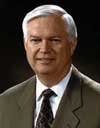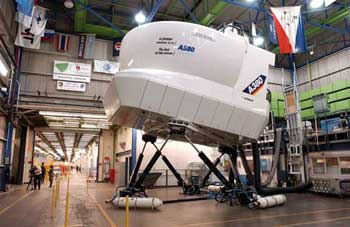QUÉBEC SPOTLIGHT
Something In the Air
| I |
t's now been 10 years since the Québec government held a referendum on independence that failed to pass. Activist sentiment behind that cause still causes corporate worry lines, but today's Québec is more about letting things fly.
From wings to windmill blades, Québec's economy is soaring on the strength of major new projects from the likes of Bombardier, Pratt & Whitney, LISI Aerospace and LM Glasfiber. And an entirely new economic development strategy is helping Greater Montréal build on the creative and diverse mix of people and companies that already populate its arrondissements.
On the surface, that might sound like reverberations of independence past, but there is plenty of project-based evidence to
back it up, starting with Bombardier's choice of Montréal for its CSeries regional jet plant. One key player in that attraction was Aeroports de Montreal (ADM).
"Our goal of transforming Montréal-Mirabel into a global aeronautics industry center is becoming a reality," said Jean Teasdale, ADM's vice president, cargo and industrial development. "We worked in partnership with the Government of QuEbec, the Town of Mirabel and other key stakeholders in order to present Bombardier with the best possible proposal. We are now directing our efforts toward Bombardier's future suppliers, to offer them the most beneficial real-estate and logistics solutions."
Mirabel was converted to a fully cargo and general aviation airport in November 2004, concurrent with completion of US$427 million worth of expansion and modernization projects at Montreal-Trudeau — all accomplished without government funds.
However, the Quebec government was more than happy to contribute to Bombardier's US$2.1-billion expansion, to the tune of US$88 million, along with the federal government's $263 million. That generosity applies to other projects in the sector too, like the one announced in June 2005 by United Technologies' Pratt & Whitney unit. The company will receive US$61 million from Invest Québec (repayable through royalties on sales) toward a $203-million jet and helicopter engine R&D project in Longueuil. The project will simultaneously consolidate 280 R&D jobs while creating 300 production jobs in the province. In all, 1,000 of the unit's 5,000 Québecois employees work in R&D.
General Electric Canada is pursuing a US$8.1-million, 100-job expansion at its Bromont plant, which makes compressor airfoils for aircraft engines, led by the CFM56, the most widely used commercial jet engine and a joint venture between GE and French company Snecma. GE employs more than 1,800 people at three Québec manufacturing plantsBromont plant manager Philippe Simonato noted that this project strengthens the position of GE Bromont on the world stage: "This new production mandate for more than 200 000 airfoils a year is an acknowledgement of the exceptional quality of the work done in Bromont. Our productivity has improved each year and we are benefiting from the many advantages available in Québec. Factors like the quality of infrastructures, the expertise and availability of workers and operating costs combine to enable us to increase our activities and position ourselves advantageously."
Some of those advantages were revealed in a 1997 study of innovative workplace design conducted by Canada's Office of Human Resources and Skills Development. Next to the GE Bromont case study headline appear the words "no union."When the company launched the plant in the early 1980s, it wished to try a "sociotech" model of management, which placed equal importance on the complex's social and technical systems. A decentralized Québecois model to be sure, and it has stood the test of time. Among the sociotech principles employed at the plant are self-responsibility for action plans, development and conflict resolution; job rotation and multi-skill development over 40-month cycles; support structures that reinforce responsibility, initiative and collaboration; and autonomy over all machinery, information and tools required to accomplish group duties. In addition, a skills-based compensation plan and profit-sharing plan were put into effect.
Among the results have been "an almost totally paperless environment and a continuous improvement of productivity and quality, reduction of down-time and of the production cycle," reads the report. "They have a very low defect rate. Employee satisfaction indicators are high, with very little turnover and very low absenteeism."
An investment of similar size to GE's is coming from France's LISI Aerospace for an aeronautical fastener plant in Montreal that will employ 140 within five years. That project will receive an interest-free loan for the purchase of production equipment. The company employs 2,300 in 16 plants across the U.S., U.K., France, Turkey and Mexico, but this is its first foray into Canada.
Meanwhile, the Bombardier growth is already having the expected supplier spinoff, most recently in July with the announcement by U.K.-based UMECO Components that it would establish operations in Québec. Part of logistics and sourcing company UMECO, the new operation, dubbed Ulogistics North America, specializes in various supply chain services for aerospace manufacturers. Its director and general manager, Liliana Deisel, has held senior positions at Nortel and Bombardier. The company hinted at possible future growth when it announced that she "will be responsible for the management of the operation's headquarters in Montréal, together with any future satellite facilities, and for the successful development of the important relationship between UMECO Components and Bombardier Aerospace."
From wings to windmill blades, Québec's economy is soaring on the strength of major new projects from the likes of Bombardier, Pratt & Whitney, LISI Aerospace and LM Glasfiber. And an entirely new economic development strategy is helping Greater Montréal build on the creative and diverse mix of people and companies that already populate its arrondissements.
Bombardier Leads
the Way to Air Superiority
The province's aerospace economy is so developed that Claude Bechard, Québec's minister for economic development, was telling the press in June that there was no need to wait any further for Canada to form an aerospace industry policy — Québec could do it all by itself.
the Way to Air Superiority
On the surface, that might sound like reverberations of independence past, but there is plenty of project-based evidence to
| Robert Brown (right), CAE president and CEO, told shareholders earlier this year that it was "appropriate" for the 60-year-old simulation and training company to return its headquarters to Montréal, which he called "the center of Canada's aerospace industry." |

|
 |
|
"Our goal of transforming Montréal-Mirabel into a global aeronautics industry center is becoming a reality," said Jean Teasdale, ADM's vice president, cargo and industrial development. "We worked in partnership with the Government of QuEbec, the Town of Mirabel and other key stakeholders in order to present Bombardier with the best possible proposal. We are now directing our efforts toward Bombardier's future suppliers, to offer them the most beneficial real-estate and logistics solutions."
Mirabel was converted to a fully cargo and general aviation airport in November 2004, concurrent with completion of US$427 million worth of expansion and modernization projects at Montreal-Trudeau — all accomplished without government funds.
However, the Quebec government was more than happy to contribute to Bombardier's US$2.1-billion expansion, to the tune of US$88 million, along with the federal government's $263 million. That generosity applies to other projects in the sector too, like the one announced in June 2005 by United Technologies' Pratt & Whitney unit. The company will receive US$61 million from Invest Québec (repayable through royalties on sales) toward a $203-million jet and helicopter engine R&D project in Longueuil. The project will simultaneously consolidate 280 R&D jobs while creating 300 production jobs in the province. In all, 1,000 of the unit's 5,000 Québecois employees work in R&D.
General Electric Canada is pursuing a US$8.1-million, 100-job expansion at its Bromont plant, which makes compressor airfoils for aircraft engines, led by the CFM56, the most widely used commercial jet engine and a joint venture between GE and French company Snecma. GE employs more than 1,800 people at three Québec manufacturing plantsBromont plant manager Philippe Simonato noted that this project strengthens the position of GE Bromont on the world stage: "This new production mandate for more than 200 000 airfoils a year is an acknowledgement of the exceptional quality of the work done in Bromont. Our productivity has improved each year and we are benefiting from the many advantages available in Québec. Factors like the quality of infrastructures, the expertise and availability of workers and operating costs combine to enable us to increase our activities and position ourselves advantageously."
Some of those advantages were revealed in a 1997 study of innovative workplace design conducted by Canada's Office of Human Resources and Skills Development. Next to the GE Bromont case study headline appear the words "no union."When the company launched the plant in the early 1980s, it wished to try a "sociotech" model of management, which placed equal importance on the complex's social and technical systems. A decentralized Québecois model to be sure, and it has stood the test of time. Among the sociotech principles employed at the plant are self-responsibility for action plans, development and conflict resolution; job rotation and multi-skill development over 40-month cycles; support structures that reinforce responsibility, initiative and collaboration; and autonomy over all machinery, information and tools required to accomplish group duties. In addition, a skills-based compensation plan and profit-sharing plan were put into effect.
Among the results have been "an almost totally paperless environment and a continuous improvement of productivity and quality, reduction of down-time and of the production cycle," reads the report. "They have a very low defect rate. Employee satisfaction indicators are high, with very little turnover and very low absenteeism."
An investment of similar size to GE's is coming from France's LISI Aerospace for an aeronautical fastener plant in Montreal that will employ 140 within five years. That project will receive an interest-free loan for the purchase of production equipment. The company employs 2,300 in 16 plants across the U.S., U.K., France, Turkey and Mexico, but this is its first foray into Canada.
Meanwhile, the Bombardier growth is already having the expected supplier spinoff, most recently in July with the announcement by U.K.-based UMECO Components that it would establish operations in Québec. Part of logistics and sourcing company UMECO, the new operation, dubbed Ulogistics North America, specializes in various supply chain services for aerospace manufacturers. Its director and general manager, Liliana Deisel, has held senior positions at Nortel and Bombardier. The company hinted at possible future growth when it announced that she "will be responsible for the management of the operation's headquarters in Montréal, together with any future satellite facilities, and for the successful development of the important relationship between UMECO Components and Bombardier Aerospace."

